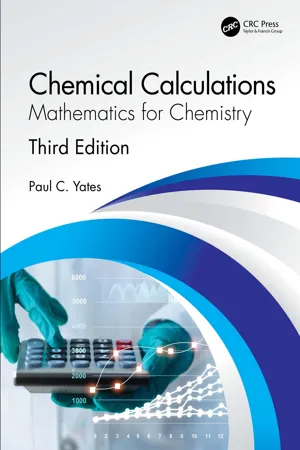Chemistry
Quantum Energy
Quantum energy refers to the discrete amount of energy associated with the movement of subatomic particles within an atom. In chemistry, it is crucial for understanding the behavior of electrons within an atom and their interactions with other atoms. Quantum energy levels are quantized, meaning they can only exist in specific, distinct amounts, and play a fundamental role in chemical bonding and reactivity.
Written by Perlego with AI-assistance
Related key terms
Related key terms
1 of 4
Related key terms
1 of 3
6 Key excerpts on "Quantum Energy"
- eBook - ePub
- Justin P. Lomont, Ian C. Stewart(Authors)
- 2013(Publication Date)
- Visible Ink Press(Publisher)
There are three main types of energy levels that physical chemists are concerned with. These are electronic, vibrational, and rotational energies. Changes in electronic energy levels occur when an electron undergoes a transition from one molecular orbital to another. Vibrational energy levels are associated with vibrations of chemical bonds in the molecule, and rotational energy levels involve the molecule rotating in space. As you could probably guess, atoms don’t have vibrational energy levels since there aren’t chemical bonds present in single atoms. Physical chemists can often learn about the structure and reactivity of molecules by studying the transitions between these energy levels.What is quantum mechanics?Quantum mechanics is a branch of physics that is needed to provide an accurate description of objects with very small mass, such as electrons. It does so using an approach that describes matter as being both similar to a particle and similar to a wave. The description of a particle in quantum mechanics is contained in something called a wave function, which can be related to the probability of an object being in any of its possible states.One interesting and counterintuitive thing we learn from quantum mechanics is that, for particles with very small mass, the position, velocity, and other quantities defining the state of the particle cannot all be precisely specified at the same time. The wavelike description offered by quantum mechanics is needed to explain why molecules have discrete energy levels, along with many other experimental observations from physical chemistry that are inconsistent with classical mechanics.What is work?Work is a name used in physics for processes that transfer energy between objects by the application of a force over a distance. Take throwing a baseball, for example. As your arm moves, your hand applies a force in the direction the baseball is moving. During the time the ball is in your hand and moving forward, you are doing work on the ball. The total amount of work done can be calculated as the product of the force you apply times the distance over which you applied force. Once it leaves your hand, you’re no longer applying a force, so you aren’t doing work on it anymore. - eBook - ePub
- James Keeler(Author)
- 2011(Publication Date)
- Wiley(Publisher)
difference that we are measuring, but we can think of this as two successive measurements of the energy. As described in the previous paragraph, each measurement of the energy will give a value which corresponds to one of the energy levels, so in spectroscopy it appears that transitions take place between these levels.3.1.1 Wavefunctions and mixed statesYou might be forgiven for thinking that it is splitting hairs to make a distinction between a molecule actually being in one of the energy levels as opposed to it appearing to be in one of the levels. However, the distinction becomes significant when we start to think about the wavefunction which describes the molecule.In quantum mechanics, the wavefunction carries within it all of the information needed to compute the properties of the molecule. Later on we will see some examples of such functions, but for now we will just take it that such functions exist. Each energy level has associated with it a different wavefunction and, just as it is commonly implied that the molecule must be in one of the energy levels, it is also often implied that the wavefunction of the molecule must be the one associated with that level.However, just as it is not true that the molecule must be in one of the energy levels, it is also not true that the wavefunction must be one associated with an energy level. This is a hard idea to come to terms with, as any book on quantum mechanics always has nice diagrams showing the energy levels alongside pictures of the associated wavefunctions (for example, as in Fig. 3.3 ). We are enticed into slotting the molecule into one of the levels and giving it the associated wavefunction! However, this is not a correct description.Fig. 3.3 The energy levels and associated wavefunctions for a particle constrained so that it can only move between x = 0 and x = L – the so-called ‘particle in a box’. We are tempted to slot the particle into one of the energy levels and hence give it the associated wavefunction. However, this is not what quantum mechanics specifies; rather the wavefunction which describes the particle is in general a mixture - eBook - ePub
Chemical Calculations
Mathematics for Chemistry, Third Edition
- Paul C. Yates(Author)
- 2023(Publication Date)
- CRC Press(Publisher)
7 Quantum MechanicsDOI: 10.1201/9781003043218-77.1 Introduction
The ideas involved in quantum mechanics can be expressed quite concisely, yet a detailed study of individual quantum mechanical systems seems to rely heavily upon mathematics. In some ways, this is unfortunate, as there is a danger that the underlying concepts may be lost in this detail. However, it is essential to be able to apply these ideas if we are to obtain results which are of use and which may be compared with experimental data. In this chapter, we will deal with the mathematics needed for some of the simpler concepts before looking at more complicated situations which need more specialized tools.7.2 Energy Level Transitions and Appropriate Precision
It is important when performing calculations to quote results to an appropriate number of figures, as discussed in Section 2.2 on page 28 . Often we are concerned not to give too many figures. However, in quantum mechanical calculations, there are times when the temptation is to give too few.Worked Example 7.1In 1963 the SI unit of length, the metre, was defined as 1 650 763.73 wavelengths of the orange-red radiation from krypton-86. Calculate the (a) wavelength, (b) frequency and (c) energy of this radiation.CHEMICAL BACKGROUNDKrypton-86 is one of the five stable isotopes of this element. Krypton is a colourless gas which is generally inert, although it can form compounds with fluorine. It finds use in fluorescent lamps. - Norio Sato(Author)
- 1998(Publication Date)
- Elsevier Science(Publisher)
CHAPTER 2THE ENERGY LEVEL OF ELECTRONS
2.1 Energy Levels of Electrons in Condensed Phases
According to quantum mechanics, electrons in atoms occupy the allowed energy levels of atomic orbitals that are described by four quantum numbers: the principal, the azimuthal, the magnetic, and the spin quantum numbers. The orbitals are usually expressed by the principal quantum numbers 1, 2, 3, …, increasing from the lowest level, and the azimuthal quantum numbers conventionally expressed by s (sharp), p (principal), d (diffuse), f (fundamental), … in order. For instance, the atom of oxygen with 8 electrons is described by (Is)2 (2s)2 (2p)4 , where the superscript indicates the number of electrons occupying the orbitals, as shown in Fig. 2-1 .Fig. 2-1 Atomic orbital levels of oxygen occupied by electrons: ε = electron energy; V(r) = potential energy of atomic oxygen nucleus; r = distance from atomic nucleus.As two atoms X and Y form a molecule XY, the atom–atom interaction splits each atomic frontier orbital into two molecular orbitals: a bonding molecular orbital at a low energy level and an antibonding molecular orbital at a high energy level as shown in Fig. 2-2 . Similarly, a molecule composed of many atoms has bonding, nonbonding, and antibonding molecular orbitals, the number of which equals the total number of atomic frontier orbitals of the constituent atoms. These molecular orbitals are filled with electrons successively from the lowest level to the highest occupied level.Fig. 2-2- eBook - ePub
Foundations for Teaching Chemistry
Chemical Knowledge for Teaching
- Keith S. Taber(Author)
- 2019(Publication Date)
- Routledge(Publisher)
10 Energy in chemistry and chemical bondingThis chapter discusses one of the key topics in the chemistry curriculum, chemical bonding. This is a highly abstract concept area where a range of models and simplifications are taught. It is also an area where students commonly develop tenacious alternative conceptions (Taber, 2013a), and thus where the teaching approach can be very important in channelling student thinking towards scientific models. One particular feature of many students’ thinking is that they learn about chemistry topics such as bonding with no cognisance of the basic physical principles they have been taught elsewhere in science. Yet if students are to develop scientific understandings of chemistry, they need to appreciate where key concepts from physics, such as force and energy, are applied. This chapter reflects this imperative by first considering the role of the energy concept in understanding school chemistry before specifically addressing chemical bonding concepts.Appreciating the physicists’ concept of energy and how this applies in chemistryEnergy is one of the most fundamental and ubiquitous concepts in science. It is also one of the most abstract. It is closely associated with another abstract concept – force. The primary responsibility for teaching these ideas falls upon the physics teacher. There are, however, consequences here for the teacher of chemistry:- To avoid the potential of confusing students, the science department as a whole should have a common way of talking about energy and force so the ideas are used consistently across different topics and science subjects.
- As energy is an important concept in chemistry, the teacher of chemistry has to rely on what has been taught and how it has been taught in another subject.
- The teacher of chemistry not only relies on what has been taught in physics but on whether students can transfer their learning in physics to other subjects.
The latter consideration is not insignificant. The question of transfer of learning, applying what has been learnt beyond the original context, is seen as a major issue in education (Lobato, 2006) because students often struggle to apply what they have learned in one context in other relevant situations. This is an example of a ‘fragmentation’ learning impediment (see Figure 3.1 ), as the learner does not make intended links with prior learning (see Figure 10.1 - eBook - ePub
- K. N. Govinda Rajan(Author)
- 2017(Publication Date)
- CRC Press(Publisher)
This could successfully explain the experimentally observed spectral lines of hydrogen. The energy levels corresponded to the atomic shells named K, L, M, etc., K being the first shell of lowest energy, L the second shell of higher energy, and so on. The shells were characterized by a principal quantum number n which assumed integer values (n = 1 for K shell). The transitions between the atomic levels gave rise to the emission of discrete spectral lines in the visible or ultraviolet regions, or in the X-ray region, depending on the strength of binding and the energy level differences. An atom, in its ground state, is in its lowest energy state (i.e., occupies the orbitals closest to the nucleus) according to the rules governing their occupancy. The unoccupied energy levels are vacant in the ground state. When the electrons of an atom absorb energy, they go to the higher energy states. The electrons quickly (in about 10 −8 seconds) return to the lower vacant states emitting the excess energy in the form of photons. The transitions occur because the electrons would like to be closest to the nucleus for maximum binding. When the energy supplied is greater than the binding energy (BE) of the electron, the electron can be knocked out of the atom—this is called ionization—and the atom becomes an ion. The electron will exist in its lowest energy state if all the electrons occupy the first shell. However, Pauli’s exclusion principle forbids all electrons to occupy the same state. According to this principle, no two electrons (or nucleons) in an atom can have identical quantum numbers. NOTE : Since the electrons can exist in two spin states (spin up or spin down) each orbital can be occupied by not more than a pair of electrons in opposite spin states. The atomic particles have half integral spin = ½ (expressed in units of ℏ). These particles follow the Pauli exclusion principle
Index pages curate the most relevant extracts from our library of academic textbooks. They’ve been created using an in-house natural language model (NLM), each adding context and meaning to key research topics.
Explore more topic indexes
Explore more topic indexes
1 of 6
Explore more topic indexes
1 of 4





